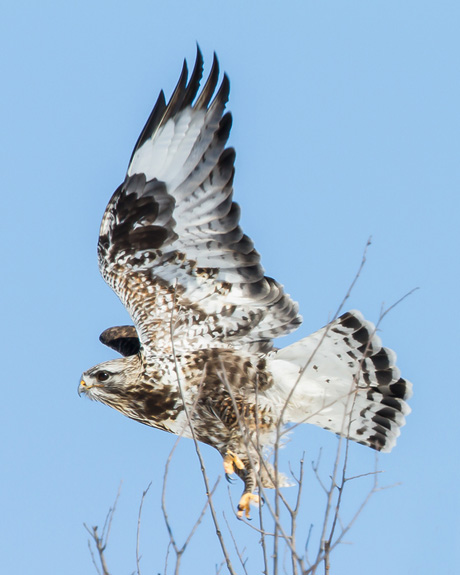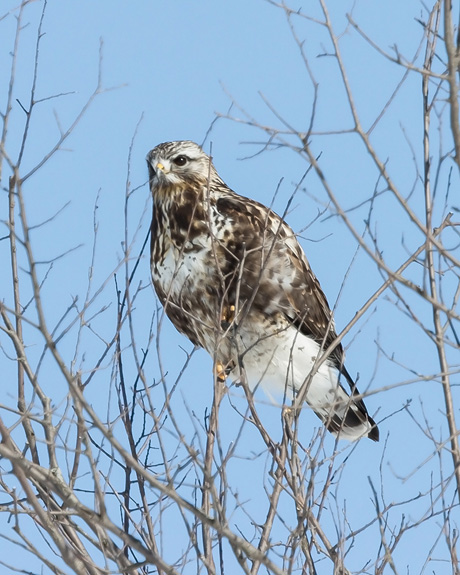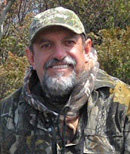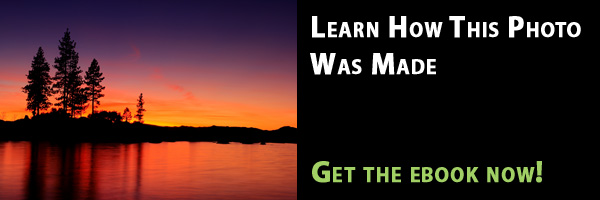
This is a photo of a Rough-legged Hawk (Buteo lagopus). It breeds in the arctic and migrates southward down into the far southern areas of western Canada and throughout much of the United States where it spends most of the winter. Its journey southward and back again is long and arduous. This particular photo was taken in southern Wisconsin in early March.
Before we get into what’s wrong with this photo, let’s discuss a few good things about it.
At first glance, this is exactly the type of photograph that gets the most attention on forums, listservs and social networks. It might even be a photo that could potentially win a photo contest. Why? Because it captures a dramatic scene that instantly makes the observer feel some kind of emotion.
Technically, the photo is good. It’s reasonably sharp overall. It’s also exposed properly, given the range of tones present (strong whites with deep blacks) and as I mentioned before, it offers some drama.
One might conclude that nothing is wrong with this image, right? Well, okay maybe the bird’s feet could’ve been a bit sharper if I used a faster shutter speed. But if I used a faster shutter speed, then that would’ve required either a wider aperture (which would’ve sacrificed depth of field), or I would’ve had to use a higher ISO (which would’ve added more noise to the photo).
What else? Maybe a look at the shots before or after this one might be better (technically better and artistically better with the same emotional effect). Nope, this is the only shot that came out reasonably well. By the way, the settings on this photo were ISO 400, f/8 @ 1/1000 second. The camera and lens I used was a Canon 7D, and a Canon 500mm f/4 (w/1.4X Canon Teleconverter), handheld with the IS set at Mode 1. The exposure was intentionally pushed to the right, roughly 2/3 overexposed, but more on that in a later post.
How about we look at one of the earlier shots I took of this bird:

Technically, this shot is equivalent to the first one: properly exposed and reasonably sharp. We might even say that it’s framed/cropped in an acceptable manner. But this one isn’t nearly as dramatic as the first one. The bird is perched and at rest. It might be a good photo for a bird guidebook, but it probably won’t get many “oohs” and “ahhhhs.” Birders and naturalists may enjoy looking at this image, but I think the general public would probably vote for the first one because it’s a much more dramatic image that shows the bird in some kind of action.
So what is it then? Why am I asking that very first question on the first photo?
Here’s why. This second photo shows the bird the way I saw it as I was driving down the road. It was either hunting for food or simply resting. But what happened when I stopped my vehicle to take a photo of it? It stayed in place for approximately 3 seconds and fled in a hurry as seen in the first photo. My presence disrupted its activity. Sure, I got a nice photo and everything, but is this behavior on my part acceptable in terms of the bird’s welfare? There’s a lot of public debate on this and that’s not the point of this post. I merely want to shed light on the fact that as photonaturalists we must take into account what our presence does to wildlife.
All across the world, in many cases, photographers disrupt the daily lives of animals. It can be argued that if the incident is isolated (as was the case when I encountered this bird), there may be little, if any, repercussions. But what if this bird was pursued all day, every day by several photographers or sight-seer’s? Wouldn’t that have a more drastic effect? Just something to think about…
Get more great tips in our free weekly newsletter.
 About the Author: Vic Berardi is a raptor lover that lives in the Midwest. He is the founder of the Illinois Beach State Park Hawk Watch and every weekend of the year you’ll find him searching for hawks and photographing them. Several of his photographs have been published in a leading raptor journal and in articles he has written. During the year he gives presentations teaching others about hawks and hawk migration. Vic also photographs dragonflies and wild flowers and is always respectful of nature and its creatures.
About the Author: Vic Berardi is a raptor lover that lives in the Midwest. He is the founder of the Illinois Beach State Park Hawk Watch and every weekend of the year you’ll find him searching for hawks and photographing them. Several of his photographs have been published in a leading raptor journal and in articles he has written. During the year he gives presentations teaching others about hawks and hawk migration. Vic also photographs dragonflies and wild flowers and is always respectful of nature and its creatures.

Leave a Reply